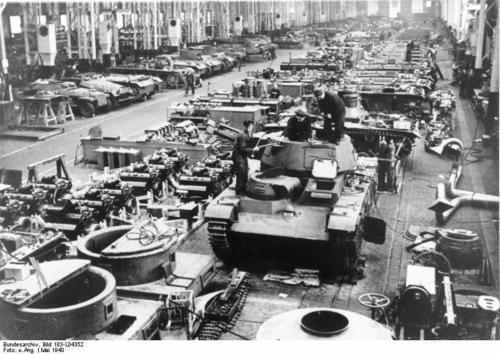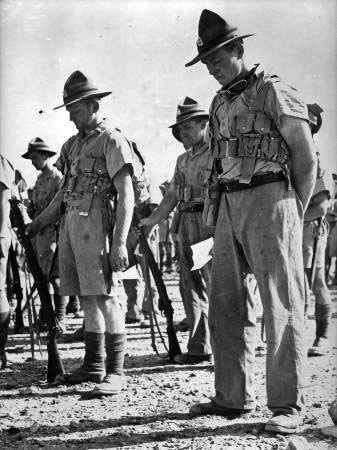Wednesday 1 May 1940
 |
| German Panzer Factory, 1 May 1940. They appear to be making Panzer IIs (Ang, Federal Archive). |
The British give up at Åndalsnes. During their mission there, they have lost 1301 killed, missing or captured. Norwegian Commander-in-chief Otto Ruge takes the HMS Diana from Åndalsnes to Tromsø to join the king and rest of the government.
Norway Army Operations: It is a miserable day for the British 15th Brigade, which suffered heavily south of Dombås. Their train to Åndalsnes derails at a bomb crater at 01:15. There are 8 dead, 30 wounded. The men then have to walk the remaining 17 miles through deep snow in order to reach the port at 09:00.
The British troops, both the 15th Brigade and 148th Brigade, leave Andalsnes that evening on a flotilla of destroyers and cruisers under Vice-Admiral Geoffrey Layton. Destroyers HMS Inglefield (D 02), HMS Diana (H 49), and HMS Delight (H 38) take troops to the light cruisers HMS Manchester and HMS Birmingham. While 5,084 servicemen are taken off, much equipment is left behind. The British are gone by 2 a.m. on 2 May 1940. The Germans do not immediately notice the departure.
Commander Lord Louis Mountbatten brings his 4 destroyers into Namsos and to take off General de Wiart’s 146th Brigade. Fog in the harbor limits the evacuees to the 850 men of the French Chasseurs Alpins.
About 4,000 Norwegian troops trapped at Lillehammer surrender.
The German 3rd Mountain Division under General Dietl counterattacks at Narvik.
German forces at Oslo and Bergen link up. Norwegian General William Steffens, who previously evacuated Voss and had set up his headquarters at Førde, disbands his troops. About 3,500 Norwegian 4th Infantry Brigade troops surrender, but the Germans allow them to simply disband and go home. Steffens leaves during the night for Tromsø with three naval aircraft. This effectively ends the campaign in southwest Norway, though there are still some Norwegian troops here and there who are un-noticed and remain active.
Norway Air Operations: The Germans transfer a battalion of the 2nd Mountain Division from Denmark to Trondheim by air.
The RAF sends a dozen bombers to attack Stavanger-Sola airfield during the day, then more aircraft to attack the same airfield and also Oslo during the night.
The Luftwaffe continues its attacks on the British-held ports in northern Norway. Stukas sink the anti-submarine trawler HMS St. Goran. The Stukas also hit the Royal Navy sloop HMS Bittern at Namsos and set it ablaze.
Norway Naval Operations: British submarine HMS Narwhal (Lt. Commander Ronald J. Burch) spots a German merchant convoy in the Kattegat about 20 miles north of Anholt, Denmark. It fires six torpedoes at the convoy. The convoy is carrying units of the 2nd Gebirgsjager Division to Norway. The Narwhal torpedoes and sinks one troop transport, the Buenos Aires (62 men and 240 horses killed), and torpedoes a second, the Bahia Castillo (10 men, 26 horses killed).
The Norwegian ships in western Norway are ordered to evacuate either to Great Britain or northern Norway. Only two do so, the auxiliary Bjerk sailed to the United Kingdom and Steinar to Northern Norway. The other Norwegian ships either have too few crews left to sail, or their commanders simply tell the men to go home.
Battle of the Atlantic: The 1,296-ton Swedish freighter Haga hits a mine laid by the British submarine HMS Narwhal in the Skagerrak east of Cape Skagen and sinks.
European Air Operations: During the night, the RAF bombs Aalborg airfield in Denmark.
The RAF sends other planes to drop mines during the night.
The Luftwaffe drops mines along the British coast.
Swedish freighter Haga strikes a mine and sinks.
Convoy OA-139 departs from Southend, Convoy SL 30 departs from Freetown, Convoy OG 28F forms at Gibraltar.
Western Front: Hitler is done waiting to invade France and the Low Countries and wants Fall Gelb to being as soon as possible. He sets a tentative start date of 5 May 1940.
Hitler is goaded on by public opinion, as expressed by journalist William Shirer broadcasting from Berlin: "What kind of war is this, where the world's two greatest armies stand facing but refrain from killing?" He recalls a typical scene: "200 yards from the Rhine, in sight of a French blockhouse, German soldiers play football."
British Military: The Military Coordination Committee (MCC) is reorganized in such a fashion as to give its leader (in the absence of Prime Minister Chamberlain) Winston Churchill more direct control over all military operations. General Ismay becomes Churchill's chief staff officer at the MCC.
German Military: General Johannes Blaskowitz takes over command of the German 9th Army.
US Military: The US Navy establishes a naval air station in San Juan, Puerto Rico.
German Government: The government designates a Krupp armaments plant at Essen as a "National Socialist model plant."
Holocaust: The Germans seal off the Lodz Ghetto. The German authorities tell the Council of Elders that they will supply the 230,000 captives with food only if they become a "useful workforce."
SS-Hauptsturmführer (captain) Rudolf Höss is appointed the first commandant of Auschwitz prison camp near the town of Oświęcim in western Poland.
Ireland: The government refuses a British offer of a "defense alliance." It re-asserts its neutrality and calls upon the US to guarantee it.
China: At the Battle of Tsaoyang-Ichang, the Japanese 11th Army opens an offensive from Hsinyang, Sui Hsien, and Chung-Hsiang toward Tsaoyang and rice granary areas in Hubei province, advancing in five columns. This is a typical Japanese "rice offensive."
The 11th Army quickly captures Mingkang, Lion's bridge, and Hsiaolintien. The Japanese Army Air Force 3rd Air Brigade, based at Hankow (Wuhan), provides air support for the 11th Army during the Tsaoyang-Ichang operation.
April 1940
April 1, 1940: Weserubung is a GoApril 2, 1940: British Subs On Alert
April 3, 1940: Churchill Consolidates Power
April 4, 1940: Missed the Bus
April 5, 1940: Mig-1 First Flight
April 6, 1940: Troops Sailing to Norway
April 7, 1940: Fleets At Sea
April 8, 1940: HMS Glowworm and Admiral Hipper
April 9, 1940: Invasion of Norway
April 10, 1940: First Battle of Narvik
April 11, 1940: Britain Takes the Faroes
April 12, 1940: Germans Consolidate in Norway
April 13, 1940: 2d Battle of Narvik
April 14, 1940: Battle of Dombås
April 15, 1940: British in Norway
April 16, 1940: Germans Cut Norway in Half
April 17, 1940: Trondheim the Target
April 18, 1940: Norway Declares War
April 19, 1940: Dombås Battle Ends
April 20, 1940: Germans Advancing in Norway
April 21, 1940: First US Military Casualty
April 22, 1940: First British Military Contact with Germans
April 23, 1940: British Retreating in Norway
April 24, 1940: British Bombard Narvik
April 25, 1940: Norwegian Air Battles
April 26, 1940: Norwegian Gold
April 27, 1940: Allies to Evacuate Norway
April 28, 1940: Prepared Piano
April 29, 1940: British at Bodo
April 30, 1940: Clacton-on-Sea Heinkel
May 1940
May 1, 1940: British Leave ÅndalsnesMay 2, 1940: British Depart Namsos
May 3, 1940: Many Norwegians Surrendering
May 4, 1940: Bader Returns
May 5, 1940: HMS Seal Survives
May 6, 1940: Allies Focus on Narvik
May 7, 1940: In The Name of God, Go!
May 8, 1940: Exit Chamberlain
May 9, 1940: Enter Churchill
May 10, 1940: Fall Gelb
May 11, 1940: Eben Emael Surrenders
May 12, 1940: Germans at Sedan
May 13, 1940: Rommel at Work
May 14, 1940: German Breakout in France
May 15, 1940: Holland Surrenders
May 16, 1940: Dash to the Channel
May 17, 1940: Germans Take Brussels
May 18, 1940: Germans Take Antwerp
May 19, 1940: Failed French Counterattack
May 20, 1940: Panzers on the Coast
May 21, 1940: Battle of Arras
May 22, 1940: Attacking Channel Ports
May 23, 1940: British Evacuate Boulogne
May 24, 1940: Hitler's Stop Order
May 25, 1940: Belgian Defenses Creaking
May 26, 1940: Operation Dynamo
May 27, 1940: King Leopold Surrenders
May 28, 1940: The Allies Take Narvik
May 29, 1940: Lille Falls
May 30, 1940: Operation Fish
May 31, 1940: Peak Day for Dynamo
2019











